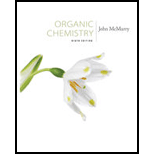
a) LiAlH4, then H3O+
Interpretation:
The product produced when p-methylbenzoic acid is treated with LiAlH4 and then with H3O+ is to be predicted.
Concept introduction:
To predict:
The product produced when p-methylbenzoic acid is treated with LiAlH4 and then with H3O+.
b) N-Bromosuccinimide in CCl4
Interpretation:
The product produced when p-methylbenzoic acid is treated with N-bromosuccinimide in CCl4 is to be predicted.
Concept introduction:
N-bromosuccinimide in CCl4 is used for introducing a Br in the benzyl carbon.
To predict:
The product produced when p-methylbenzoic acid is treated with N-bromosuccinimide in CCl4.
c) CH3MgBr in ether, then H3O+
Interpretation:
The product produced when p-methylbenzoic acid is treated with CH3MgBr and then with H3O+ is to be predicted.
Concept introduction:
Grignard reagents will react with the carboxyl hydrogen to yield
To predict:
The product produced when p-methylbenzoic acid is treated with CH3MgBr and then with H3O+.
d) KMnO4, H3O+
Interpretation:
The product produced when p-methylbenzoic acid is treated with KMnO4 in the presence of H3O+ is to be predicted.
Concept introduction:
When treated with KMnO4 in the presence of H3O+, the side chain in
To predict:
The product produced when p-methylbenzoic acid is treated with KMnO4 in the presence of H3O+.
Trending nowThis is a popular solution!

Chapter 20 Solutions
Organic Chemistry - With Access (Custom)
- Determine the pH of solution of HC3H5O2 By constructing an ICE table writing the equilibrium constant expression, and using this information to determine the pH. The Ka of HC3H5O2 is 1.3 x 10-5arrow_forwardDetermine if the following salt is neutral, acidic or basic. If acidic or basic, write the appropriate equilibrium equation for the acid or base that exists when the salt is dissolved in aqueous solution. If neutral, simply write only NR. Be sure to include the proper phases for all species within the reaction LiNO3arrow_forwardAn unknown weak acid with a concentration of 0.410 M has a pH of 5.600. What is the Ka of the weak acid?arrow_forward
- (racemic) 19.84 Using your reaction roadmaps as a guide, show how to convert 2-oxepanone and ethanol into 1-cyclopentenecarbaldehyde. You must use 2-oxepanone as the source of all carbon atoms in the target molecule. Show all reagents and all molecules synthesized along the way. & + EtOH H 2-Oxepanone 1-Cyclopentenecarbaldehydearrow_forwardR₂ R₁ R₁ a R Rg Nu R₂ Rg R₁ R R₁₂ R3 R R Nu enolate forming R₁ R B-Alkylated carbonyl species or amines Cyclic B-Ketoester R₁₁ HOB R R₁B R R₁₂ B-Hydroxy carbonyl R diester R2 R3 R₁ RB OR R₂ 0 aB-Unsaturated carbonyl NaOR Aldol HOR reaction 1) LDA 2) R-X 3) H₂O/H₂O ketone, aldehyde 1) 2°-amine 2) acid chloride 3) H₂O'/H₂O 0 O R₁ R₁ R R₁ R₁₂ Alkylated a-carbon R₁ H.C R₁ H.C Alkylated methyl ketone acetoacetic ester B-Ketoester ester R₁ HO R₂ R B-Dicarbonyl HO Alkylated carboxylic acid malonic ester Write the reagents required to bring about each reaction next to the arrows shown. Next, record any regiochemistry or stereochemistry considerations relevant to the reaction. You should also record any key aspects of the mechanism, such as forma- tion of an important intermediate, as a helpful reminder. You may want to keep track of all reactions that make carbon-carbon bonds, because these help you build large molecules from smaller fragments. This especially applies to the reactions in…arrow_forwardProvide the reasonable steps to achieve the following synthesis.arrow_forward
 Organic ChemistryChemistryISBN:9781305580350Author:William H. Brown, Brent L. Iverson, Eric Anslyn, Christopher S. FootePublisher:Cengage Learning
Organic ChemistryChemistryISBN:9781305580350Author:William H. Brown, Brent L. Iverson, Eric Anslyn, Christopher S. FootePublisher:Cengage Learning

